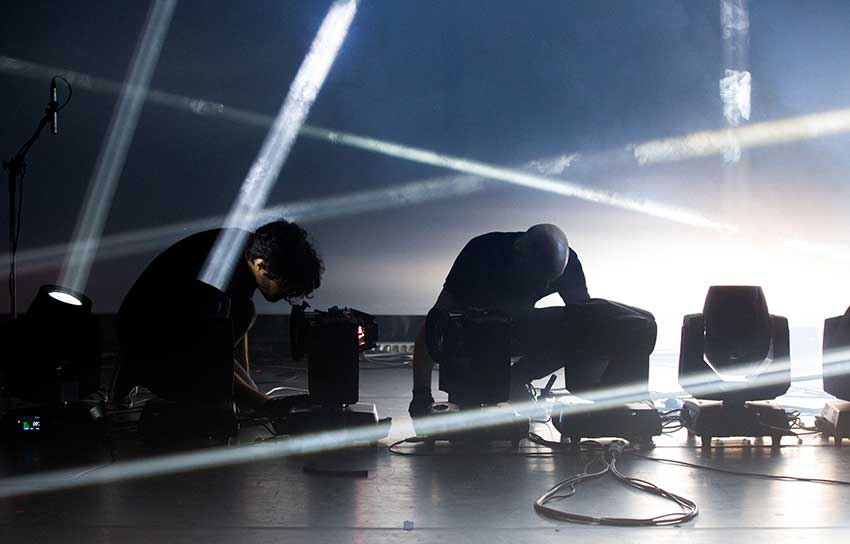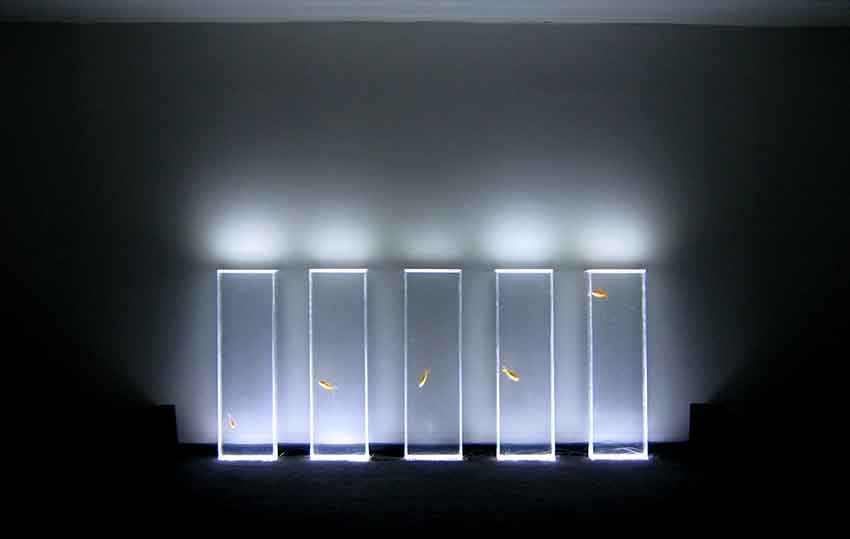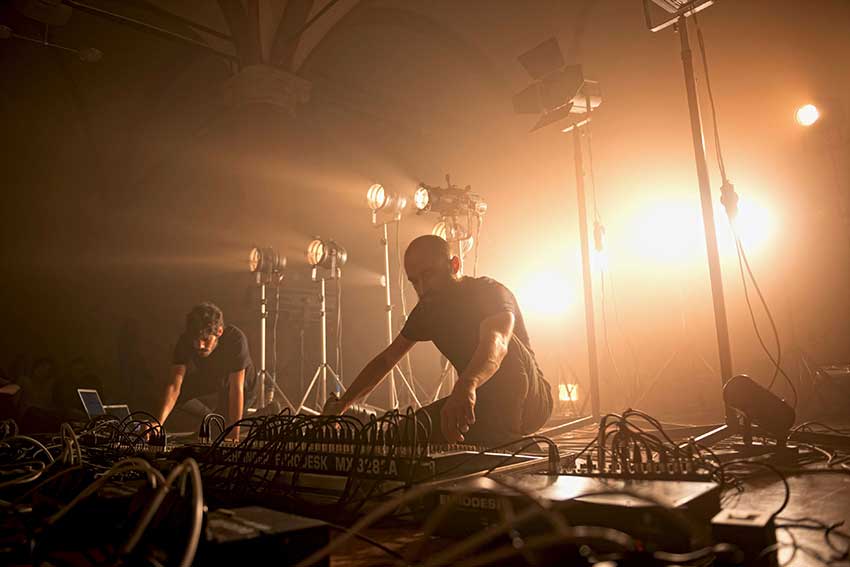Interview Allan Gardner

Quiet Ensemble is an Italian art collective comprised of Fabio di Salvo and Bernardo Vercelli. Founded in 2009, they aimed to explore the relationship between nature and technology. Producing performances and installations, the duo attempt to blur the lines between the two spaces, often utilising one to bring about an alteration of the other. Their objective is to create balance, to establish cohesion between the organic and artificial through utilising the inherent chaos therein.
With installations like Ephemeral, Quiet Ensemble produces an immersive environment for public interaction. Using only water vapour, the duo produced a ground-level cloud formation – changing not only with the vapour produced artificially but equally by the cloud’s position within the environment. Audience members became participants, walking in the clouds and isolated from the world around them.
Through light and sound, Quiet Ensemble altered the experience, overwhelming the environment. The documentation for the project is dissonant, with droning synths giving way to sharp electronic pulses as lights strobe and hooded figures make their way through an artificial mist. They equally produce using natural elements we could consider to be banal. In the performance Natura Morta, pieces of fruit are turned into instruments with their naturally occurring acids’ minor electronic frequencies boosted to create an audible sound.
The pieces of fruit are placed on plexiglass boxes, functioning as homemade midi controllers used to modulate the sound. Due to the unique genetic composition of each fruit, the sound emitted differs from fruit to fruit. The intervention of the midi controller is important in this instance; it points to a control of the natural currents. In this instance, the controller is the tool by which the potential to make sound becomes the potential to make music, with the fruit transitioning fully into the position of the instrument.
This distinction is essential when discussing works like Natural Morta in that the unique technologies produced as part of the performance differ greatly from something like placing a contact mic on a pineapple. The sound, in this instance, is generated by the fruit – the player is merely manipulating it.
The group’s continues exploration of the natural world’s elemental properties provides a unique perspective on our position within it. Treating technological and organic components as collaborators, their performances and installations function as an opportunity to be subsumed by the connection. The viewer is liberated from their preconceptions of the components, from water to a pineapple, understanding the potential of a sympathetic relationship between the natural and unnatural.


Right: The Enlightenment, Robot Festival, (2014). Photo credit: Elisa D’Errico
For our audience that is not familiar with your work and background, could you tell us a bit about who is behind Quiet Ensemble, your interests and your inspirations?
Bernardo: Basically, the Quiet Ensemble is composed of Bernardo and Fabio; we found a good balance between us, our interests and our artistic goals.
We get inspiration from the unexpected; we get a spark whenever we see a microscopic event appearing to us, little things, the fall of a leaf or a reflection of a puddle; all those childlike wonders become unique theatre pieces to us, so we become the very special spectators. We’d like to involve our audience in the same theatre, watching and listening to the same fragile orchestras we experience.
Fabio: Quiet was born in 2009, and we started to explore the relationship between technology and nature. We made some installations, often using living systems, and then we explored also the performance world, trying to develop the concept in live performance, exploring the magic world hidden around us and making it visible and audible through technology.
Your research goes through the observation of balance between chaos and control, nature and technology and in your installations and performances, you merge elements that take form from the relation between organic and artificial subjects; Could you tell us a bit about all these ideas came together and what sparked your interest in merging them?
Bernardo: We love becoming spectators of our own pieces. Really often, we create subjects that have a great percentage of unexpected and working with organic elements and nature; we get easily surprised by unknown behaviour.
We focus on creations where the objects become subjects, where lamps make sound, and mechanisms get opened and vivisected, making visible the heart of the machine, revealing “what’s behind”.
Fabio: We are interested in showing to our audience some little things that exist around us, especially in the natural world, and sometimes we are the audience of some “nature shows” as well, and it often happens casually.
So when we are impressed and touched by some natural event, we try to bring this to our show or installation. Many of our installations were born from casualty, and we love it. We often need to use technology in order to amplify and make these little things visible to the audience.
During Sónar+D 2019, you presented your performance Back Symphony. In it, you built up a symphony by introducing the elements (light, sound, noise, machinery) gradually that ceased to exist when it was assembled. How did you come up with the idea?
Bernardo: The creation of Back Symphony It has been a natural development of The Enlightenment, an orchestra of lights we did back in 2014. In Back Symphony, we interact with the machines as shadows, technicians at their mercy; once the machines are working, they take over, and humans are useless. The idea follows the concept of “behind the scenes” in the sense that we like to share the sound behind the light, the error behind the perfect machine, the painting of the snail, and the show behind the show.
Fabio: We are fascinated by hidden phenomena, and these strange mechanical lights caught our attention, especially for all the little noises and sound they made. So we started to explore this sound and also the limit of movement of these lamps, and we wanted to use them as instruments. We capsised the use of these lights because they usually “just” make light for music shows, and we use them to play sound instead. And the concert is a robotic concert where all the sounds and noises come from the mechanical parts of them.
Are we collaborating with machines, or are machines collaborating with us?
Bernardo: We collaborate with animals. We use machines and collaborate with their possible, lovely error.
Fabio: We like to say 50% and 50 %.
What directions do you see taking your work into?
Bernardo: wow.. we’re really interested to know about that.
Fabio: we keep researching everything that caught our artistic attention. At this moment, we are working on some different projects, and we can’t wait to show them.
What is your chief enemy of creativity?
Bernardo: Comfort.
Fabio: We seek the right balance between concept and technology. It is very easy to use new technology and put it as it is at the centre of an exhibition. We want to explore new technology as something that can help us to show our concepts and ideas.
You couldn’t live without…
Bernardo: Nature.
Fabio: Curiosity. We think it is the engine of the world, and maybe one day we will be able to amplify it.






